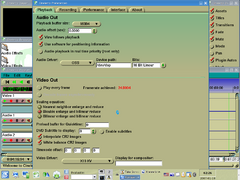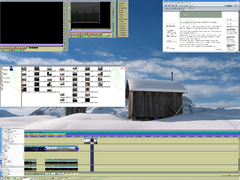The 1024×768 screen of my laptop from ESC is quite small. I got it when I had to change some preferences in Cinelerra. The confirmation buttons were far below the edge of the screen.
Well, manually editing files in ~/.bcast is a bit time-consuming, so i really needed these buttons 😉
There were two ways to press the button: either use bigger, so called ‘virtual’ desktop, or try to run two X serers with different layouts.
Using virtual desktops is more simple. Just add “Virtual x y” lines to /etc/X11/xorg.conf and you are done. The minor problem is that when the window gets maximized, it expand over the whole virtual desktop, not just the visible part of it.
The other way is more interesting. I should mention I prefer KDM as desktop manager.
So, good old Goooooogle showed me the way: [1] and [2]. The first one is quite interesting, but seems like kdm from KDE 3.5.5 is not reading Xservers file at all.
The temporary workaround is to use the ugly XDM as desktop manager.
So, the XDM solution is:
edit /etc/X11/xdm/Xservers and choose one of the methods proposed:
# three ways: either use ‘-layout’ option and specify ServerLayout:
:0 local /usr/bin/X :0 vt7 -nolisten tcp -layout Default
:1 local /usr/bin/X :1 vt8 -nolisten tcp -layout Huge# or use separate xorg.conf file, like this
#:0 local /usr/bin/X :0 vt7 -nolisten tcp -config /etc/X11/xorg.conf
#:1 local /usr/bin/X :1 vt8 -nolisten tcp -config /etc/X11/xorg.virtual.conf# or use ‘-screen’ option
#:0 local /usr/bin/X :0 vt7 -nolisten tcp -screen Default\ Screen
#:1 local /usr/bin/X :1 vt8 -nolisten tcp -screen Huge\ Screen
and either create xorg.virtual.conf or edit xorg.conf accordingly:
…
Section “Screen”
Identifier “Default Screen”
Device “Generic Video Card”
Monitor “Generic Monitor”
DefaultDepth 24
…
SubSection “Display”
Depth 24
Modes “1024×768” “1280×1024” “1600×1200”
EndSubSection
EndSectionSection “Screen”
Identifier “Huge Screen”
Device “Generic Video Card”
Monitor “Generic Monitor”
DefaultDepth 24
…
SubSection “Display”
Depth 24
Modes “1024×768” “1280×1024” “1600×1200”
Virtual 2400 1600
EndSubSection
EndSectionSection “ServerLayout”
Identifier “Default”
Screen “Default Screen”
…
EndSectionSection “ServerLayout”
Identifier “Huge”
Screen “Huge Screen”
…
EndSection
stop KDM, start XDM and you’re done.
And now, the most interesting part (for me): KDM configuration.
I used single xorg.conf file with multiple ServerLayout’s
/etc/kde3/kdm/kdmrc:
# KDM master configuration file
…
[General]
…
# List of permanent displays. Displays with a hostname are foreign. A display
# class may be specified separated by an underscore.
# Default is “:0”
StaticServers=:0,:1
# List of on-demand displays. See StaticServers for syntax.
# Default is “”
ReserveServers=:2,:3
# VTs to allocate to X-servers. A negative number means that the VT will be
# used only if it is free. If all VTs in this list are used up, the next free
# one greater than the last one in this list will be allocated.
# Default is “”
ServerVTs=-7,-8,-9,-10
# TTYs (without /dev/) to monitor for activity while in console mode.
# Default is “”
ConsoleTTYs=tty1,tty2,tty3,tty4,tty5,tty6
…# Greeter config for all displays
[X-*-Greeter]
…
LogoArea=Clock
…
# Default is “Welcome to Debian at %n”
GreetString=Welcome to Debian at %n %d
…# Core config for 1st local display
[X-:0-Core]
# The VT the X-server should run on; auto-assign if zero, don’t assign if -1.
# Better leave it zero and use ServerVTs.
# Default is 0
#ServerVT=7
…
ServerArgsLocal=-nolisten tcp -layout Default# Core config for local displays
[X-:1-Core]
ServerAttempts=2
ServerVT=8
# The command line to start the X-server, without display number and VT spec.
# This string is subject to word splitting.
# Default is “/usr/bin/X -br”
ServerCmd=/usr/bin/X :1 -br
# Additional arguments for the X-servers for local sessions.
# This string is subject to word splitting.
# Default is “”
ServerArgsLocal=-nolisten tcp -layout Huge
AllowNullPasswd=true
AllowShutdown=All# Greeter config for 1st local display
[X-:0-Greeter]
…
That’s all. Enjoy.


